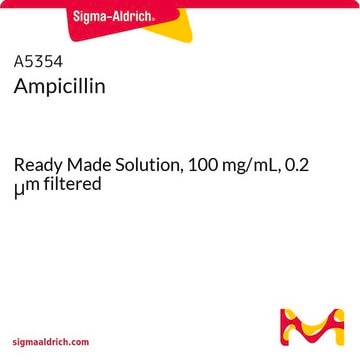The product is stable for nearly 3 years when stored at room temperature. There is no specific requirement to store L2542 at 2-8°C. However, if the container is opened and closed, there is a possibility of contamination through routine use.
L3522
Caldo LB (Miller)
Highly-referenced nutrient-rich microbial growth powder medium, suitable for regular E.coli culture
Sinónimos:
Caldo LB de Miller, Caldo Luria
Seleccione un Tamaño
Seleccione un Tamaño
About This Item
Productos recomendados
grade
for molecular biology
Quality Level
description
Miller′s Modification, 10 g/L NaCl
sterility
non-sterile
form
powder
composition
NaCl, 10 g/L
Tryptone, 10 g/L
Yeast Extract, 5 g/L
pH
6.8-7.2(2.5% solution)
application(s)
food and beverages
storage temp.
room temp
suitability
nonselective for Escherichia coli
nonselective for coliforms
General description
Application
Idóneo para cultivo no selectivo de cepas de E. coli para clonación, producción de plásmidos ADN y producción de proteínas recombinantes. También es adecuado para el cultivo selectivo cuando se añaden los antibióticos apropiados.
Biochem/physiol Actions
Features and Benefits
- Fácil escalado utilizando tamaños de envase mayores
- Una alternativa económica al líquido
- Una formulación estándar
Preparation Note
2. Esterilice en autoclave durante 15 minutos a 121 ºC.
Para preparar el medio de Luria, Adams y Ting (también conocido como caldo LC: Agregue asépticamente 25 ml de cloruro de calcio 0,1 M estéril después de haberlo esterilizado en autoclave.
Reconstitution
related product
Storage Class
11 - Combustible Solids
wgk_germany
WGK 3
flash_point_f
Not applicable
flash_point_c
Not applicable
Elija entre una de las versiones más recientes:
¿Ya tiene este producto?
Encuentre la documentación para los productos que ha comprado recientemente en la Biblioteca de documentos.
Los clientes también vieron
Artículos
SeqPlex™-I WTA kit amplifies RNA for NGS, enabling genomic studies from limited samples.
Genetic engineering enables large-scale expression and isolation of recombinant proteins for research purposes.
Protocolos
General protocols for growth of competent cells in microbial medium.
Contenido relacionado
KOD One™ PCR Master Mix overview for ultra-fast PCR with high specificity, fidelity, and yield
-
What is the recommended duration for using this item after autoclaving, and can it be stored at 4 degrees Celsius for extended or long-term use?
1 answer-
Helpful?
-
-
What are the differences among the Luria, Lennox and Miller LB formulations?
1 answer-
LB, (originally termed lysogeny broth) was initially composed of tryptone, yeast extract, NaCl and glucose. Soon after, the glucose was omitted (Miller's version), and later the NaCl content lowered by half (Lennox's version). For some applications, even lower salt is required (Luria's low salt version).
Helpful?
-
-
Which bacterial culture medium is the best choice for my application?
1 answer-
Each of the broths will likely grow E. coli very well, but there are still general guidelines for choosing a broth when you are working without a protocol. Generally:LB - Miller and LB - Lennox are used for E. coli growth and maintanence, DNA plasmid production and protein production. The Lennox formulation has a lower salt content required for some salt-sensitive selection antibiotics.LB - Luria low salt is used for special applications where the E. coli growth or other constraints require the lowest possible salt content.Terrific Broth is used for higher yield protein production and high yield DNA plasmid production, because of the faster growth of the E. coli in this medium.SOB is used for protein production, DNA plasmid production and the generation of high-efficiency competent cells.SOC is used for initial growth of competent cells and the transformation procedure.
Helpful?
-
-
Will adding magnesium to the culture medium increase cell density?
1 answer-
In microbial broth formulations that do not already contain magnesium, the addition of 10-20 mM MgCl2 or MgSO4 may increase cell densities. You may need to also increase the shaking speed of the incubator.
Helpful?
-
-
What is the difference among the LB - Miller products?
1 answer-
LB - Miller is available in many types to suit your needs. The different product formats include powder and liquid form. The powder form is also available with agar for easy LB-agar plate preparation.L2542 (LB Miller liquid)L3522 (LB Miller powder)L3147 (LB Miller powder with agar)
Helpful?
-
-
What is the Department of Transportation shipping information for this product?
1 answer-
Transportation information can be found in Section 14 of the product's (M)SDS.To access the shipping information for this material, use the link on the product detail page for the product.
Helpful?
-
Active Filters
Nuestro equipo de científicos tiene experiencia en todas las áreas de investigación: Ciencias de la vida, Ciencia de los materiales, Síntesis química, Cromatografía, Analítica y muchas otras.
Póngase en contacto con el Servicio técnico














